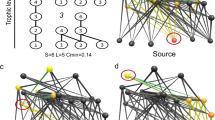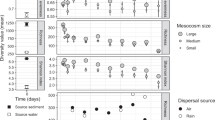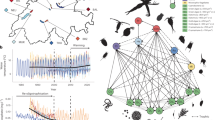Abstract
Droughts are intensifying across the globe1,2, with potentially devastating implications for freshwater ecosystems3,4. We used new network science approaches to investigate drought impacts on stream food webs and explored potential consequences for web robustness to future perturbations. The substructure of the webs was characterized by a core of richly connected species5 surrounded by poorly connected peripheral species. Although drought caused the partial collapse of the food webs6, the loss of the most extinction-prone peripheral species triggered a substantial rewiring of interactions within the networks’ cores. These shifts in species interactions in the core conserved the underlying core/periphery substructure and stability of the drought-impacted webs. When we subsequently perturbed the webs by simulating species loss in silico, the rewired drought webs were as robust as the larger, undisturbed webs. Our research unearths previously unknown compensatory dynamics arising from within the core that could underpin food web stability in the face of environmental perturbations.
This is a preview of subscription content, access via your institution
Access options
Subscribe to this journal
Receive 12 print issues and online access
$209.00 per year
only $17.42 per issue
Buy this article
- Purchase on Springer Link
- Instant access to full article PDF
Prices may be subject to local taxes which are calculated during checkout



Similar content being viewed by others
References
Hartmann, D. L. et al. in Climate Change 2013: The Physical Science Basis (eds Stocker, T. F. et al.) Ch. 1 (IPCC, Cambridge Univ. Press, 2013).
Kendon, M., Marsh, T. & Parry, S. The 2010–2012 drought in England and Wales. Weather 68, 88–95 (2013).
Milly, P. C. D., Dunne, K. A. & Vecchia, A. V. Global pattern of trends in streamflow and water availability in a changing climate. Nature 438, 347–50 (2005).
Vorosmarty, C. J. et al. Global threats to human water security and river biodiversity. Nature 467, 555–561 (2010).
Ma, A. & Mondragón, R. J. Rich-cores in networks. PLoS ONE 10, e0119678 (2015).
Ledger, M. E., Brown, L. E., Edwards, F. K., Milner, A. M. & Woodward, G. Drought alters the structure and functioning of complex food webs. Nature Clim. Change 3, 223–227 (2013).
Closs, G. P. & Lake, P. S. Spatial and temporal variation in the structure of an intermittent-stream food web. Ecol. Monogr. 64, 1–21 (1994).
Lytle, D. A. & Poff, N. L. Adaptation to natural flow regimes. Trends Ecol. Evol. 19, 94–100 (2004).
Lake, P. S. Ecological effects of perturbation by drought in flowing waters. Freshwat. Biol. 48, 1161–1172 (2003).
Woodward, G. et al. Climate change impacts in multispecies systems: drought alters food web size structure in a field experiment. Phil. Trans. R. Soc. B 367, 2990–2997 (2012).
McKee, D. & Atkinson, D. The influence of climate change scenarios on populations of the mayfly Cloeon dipterum. Hydrobiologia 441, 55–62 (2000).
Tylianakis, J. M., Tscharntke, T. & Lewis, O. T. Habitat modification alters the structure of tropical host–parasitoid food webs. Nature 445, 202–205 (2007).
Petchey, O. L., Brose, U. & Rall, B. C. Predicting the effects of temperature on food web connectance. Phil. Trans. R. Soc. B 365, 2081–2091 (2010).
Woodward, G., Perkins, D. M. & Brown, L. E. Climate change and freshwater ecosystems: impacts across multiple levels of organization. Phil. Trans. R. Soc. B 365, 2093–2106 (2010).
Ebenman, B. & Jonsson, T. Using community viability analysis to identify fragile systems and keystone species. Trends Ecol. Evol. 20, 568–575 (2005).
Borrvall, C. & Ebenman, B. Biodiversity and persistence of ecological communities in variable environments. Ecol. Complex. 5, 99–105 (2008).
Garlaschelli, D., Caldarelli, G. & Pietronero, L. Universal scaling relations in food webs. Nature 423, 165–168 (2003).
Borgatti, S. P. & Everett, M. G. Models of core/periphery structures. Soc. Netw. 21, 375–395 (1999).
Csermely, P., London, A., Wu, L.-Y. & Uzzi, B. Structure and dynamics of core/periphery networks. J. Complex Netw. 1, 93–123 (2013).
Csete, M. & Doyle, J. Bow ties, metabolism and disease. Trends Biotechnol. 22, 446–450 (2004).
Brede, M. Coordinated and uncoordinated optimization of networks. Phys. Rev. E 81, 066104 (2010).
Derenyi, I., Farkas, I., Palla, G. & Vicsek, T. Topological phase transitions of random networks. Phys. A 334, 583–590 (2003).
Kitano, H. Biological robustness. Nature Rev. Genet. 5, 826–837 (2004).
Thompson, R. M. et al. Food webs: reconciling the structure and function of biodiversity. Trends Ecol. Evol. 27, 689–697 (2012).
Burgos, E. et al. Why nestedness in mutualistic networks? J. Theor. Biol. 249, 307–313 (2007).
Ledger, M. E., Edwards, F. K., Brown, L. E., Milner, A. M. & Woodward, G. Impact of simulated drought on ecosystem biomass production: an experimental test in stream mesocosms. Glob. Change Biol. 17, 2288–2297 (2011).
Zhou, S. & Mondragon, R. J. The rich-club phenomenon in the internet topology. IEEE Commun. Lett. 8, 180–182 (2004).
Maslov, S., Sneppen, K. & Zaliznyak, A. Detection of topological patterns in complex networks: correlation profile of the internet. Phys. A 333, 529–540 (2004).
Dunne, J. A., Williams, R. J. & Martinez, N. D. Network structure and biodiversity loss in food webs: robustness increases with connectance. Ecol. Lett. 5, 558–567 (2002).
Krause, A. E., Frank, K. A., Mason, D. M., Ulanowicz, R. E. & Taylor, W. W. Compartments revealed in food-web structure. Nature 426, 282–285 (2003).
Ledger, M. E. et al. Extreme climatic events alter aquatic food webs. A synthesis of evidence from a mesocosm drought experiment. Adv. Ecol. Res. 48, 343–395 (2013).
Lancaster, J. & Ledger, M. E. Population-level responses of stream macroinvertebrates to drying can be density-independent or density-dependent. Freshwat. Biol. 60, 2559–2570 (2015).
Harris, R. M. L. The Effect of Experimental Drought Disturbance on Macroinvertebrate Assemblages in Stream Mesocosms PhD thesis, Univ. Birmingham (2006).
Parry, S., Hannaford, J., Lloyd-Hughes, B. & Prudhomme, C. Multi-year droughts in Europe: analysis of development and causes. Hydrol. Res. 43, 689–706 (2012).
Beniston, M. et al. Future extreme events in European climate: an exploration of regional climate model projections. Climatic Change 81, 71–95 (2007).
Ledger, M. E., Harris, R. M. L., Armitage, P. D. & Milner, A. M. Disturbance frequency influences patch dynamics in stream benthic algal communities. Oecologia 155, 809–819 (2008).
Brown, L. E., Edwards, F. K., Milner, A. M., Woodward, G. & Ledger, M. E. Food web complexity and allometric scaling relationships in stream mesocosms: implications for experimentation. J. Anim. Ecol. 80, 884–895 (2011).
Acknowledgements
X.L. and C.G. were supported by Queen Mary University of London. X.L. was additionally supported by the Chinese Scholarship Council and C.G. was additionally supported by the Freshwater Biological Association. This paper is a contribution to Imperial College’s Grand Challenges in Ecosystems and the Environment initiative. The project was supported by a FBA/Natural Environmental Research Council (NERC) postdoctoral fellowship to M.E.L. and NERC grants NER/B/S/2002/00215 and NE/J02256X/1. We would like to thank P. Armitage, F. K. Edwards and R. Harris for their contribution to the original experimental project and J. M. Olesen for his comments on the manuscript.
Author information
Authors and Affiliations
Contributions
M.E.L. and A.M.M. conducted the mesocosm experiments. M.E.L., L.E.B., A.M.M. and G.W. generated the food web data set. R.J.M. and A.M. designed the network analyses. X.L. implemented the network research. X.L. and C.G. analysed the results. C.G., M.E.L. and A.M. wrote the manuscript with input from all authors. All authors discussed the results and reviewed the final manuscript.
Corresponding authors
Ethics declarations
Competing interests
The authors declare no competing financial interests.
Supplementary information
Supplementary Information
Supplementary Information (PDF 1012 kb)
Rights and permissions
About this article
Cite this article
Lu, X., Gray, C., Brown, L. et al. Drought rewires the cores of food webs. Nature Clim Change 6, 875–878 (2016). https://doi.org/10.1038/nclimate3002
Received:
Accepted:
Published:
Issue Date:
DOI: https://doi.org/10.1038/nclimate3002
This article is cited by
-
Human settlements in headwater catchments are associated with generalist stream food webs
Hydrobiologia (2021)
-
Drought alters the biogeochemistry of boreal stream networks
Nature Communications (2020)
-
Node-Level Resilience Loss in Dynamic Complex Networks
Scientific Reports (2020)
-
Estimating degree–degree correlation and network cores from the connectivity of high–degree nodes in complex networks
Scientific Reports (2020)
-
Extreme rainfall events alter the trophic structure in bromeliad tanks across the Neotropics
Nature Communications (2020)



